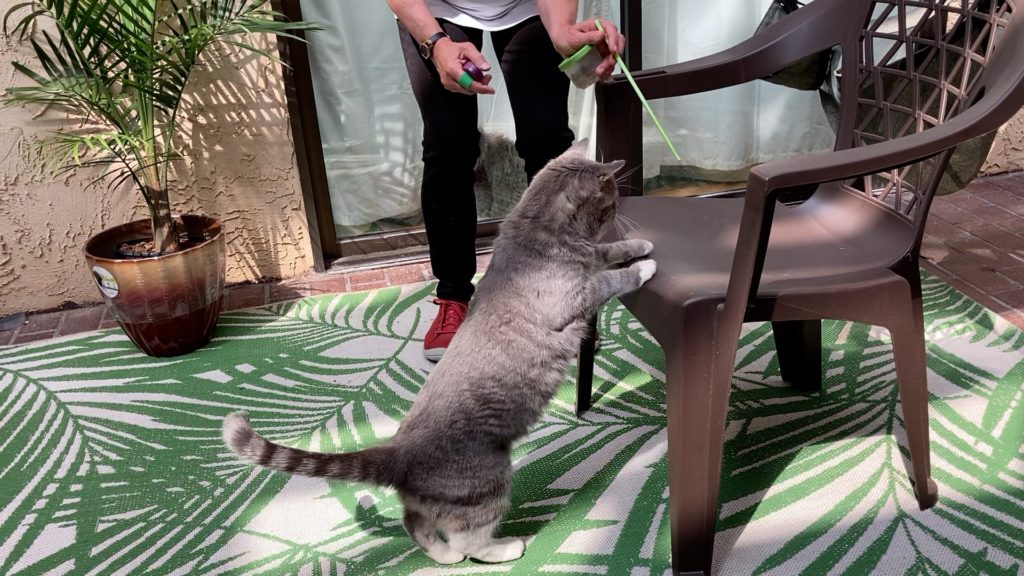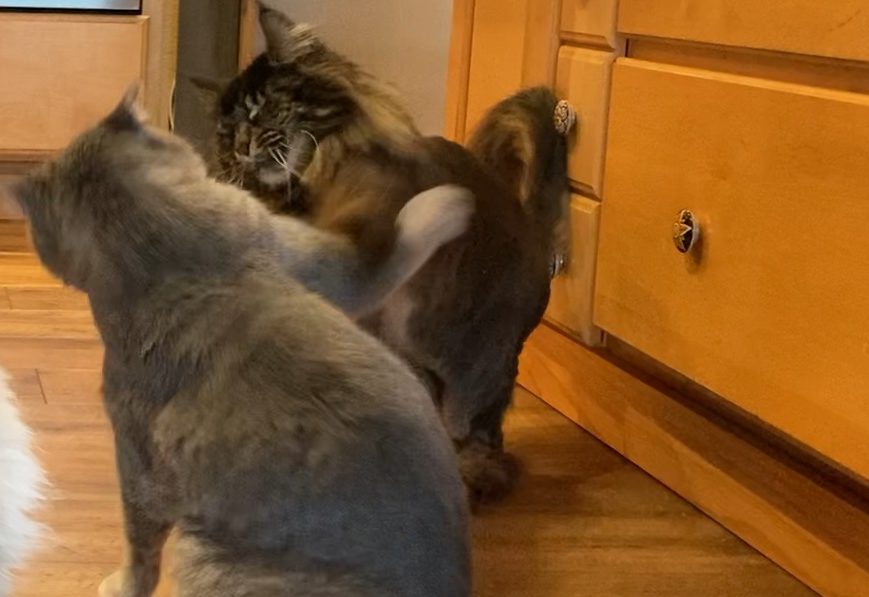
Sometimes when your cat behaves “badly”, you are able to address what triggers the misbehavior and life goes back to “normal”: you add a new litter box and the house-soiling stops; you start taking your “bully” cat for walks on a leash and everyone settles back down again. Problem solved!
Other times, you feel you’ve taken care of what triggers the misbehavior but your cat continues to, say, pee in the bathtub. And in still other instances, you can’t eliminate the stressors triggering the behavior, and the behavior persists. For example, you just don’t have the finances to get a bigger house but you don’t want to re-home any of the cats.
Anxiety and misbehavior in your cat
When your cat is stressed, he can become anxious and fearful. Anxiety is a normal reaction to stress and helps the cat respond to perceived danger. One way your cat may let you know she is anxious and fearful, is by “misbehaving”. She may avoid her litter box and or hide and strike out at you when you try to pick her up.
Your vet might recommend a behavior modification plan and an anxiolytic (anti-anxiety) medication to deal with the anxiety and misbehavior in your cat. Behavior modification aims to give the cat a way to cope with the stress that is giving rise to the “misbehavior”. Anxiolytics reduce your cat’s anxiety and put him in a positive emotional state, making him more receptive to behavior modification.
Fluoxetine: Rx for anxiety
Let’s take a look at Fluoxetine, a medication that is frequently prescribed by veterinarians to treat anxiety.
In human circles, fluoxetine is more commonly known by the brand name Prozac. It is a “selective serotonin re-uptake inhibitor” (SSRI).
Serotonin is a neurotransmitter, a chemical that carries “messages” between neurons. Neurotransmitters are typically reabsorbed in the neuron once the “messaging” is done but SSRI’s keep serotonin from being reabsorbed, resulting in more serotonin being available to carry messages between neurons. Serotonin is thought to regulate mood, digestion, and sleep among other metabolic processes (see SSRIs mayoclinic.org).
Your cat should be calmer and less anxious when taking fluoxetine.
House-soiling and aggression toward people are two of the more common behavioral problems in cats. Let’s take a quick look at two cases where fluoxetine and behavior modification helped manage feline anxiety and misbehavior.
Susie, a 13 year old female cat
Problem Behavior: House-soiling in variety of locations with chronic diarrhea
When Susie was 11 years old, her feline house-mate passed away and her owner adopted a younger cat. Susie began pooping outside the box. After most of a year, the owner felt the cats got along OK but house-soiling and diarrhea continued. The owner found Susie “aloof” and difficult to handle. Susie was surrendered to a veterinary clinic when she was 13 years old.
A Plan for Susie
Medical plan: treat the diarrhea
Behavioral plan:
- Desensitize Susie to interacting with people
- Gradually introduce Susie to the other cats in the clinic
Susie’s Timeline:
- Susie is surrendered to the vet clinic in mid-May 2021. She is fearful and reluctant to interact with people and other cats and is placed in a “room of her own”.
- In early July, Susie begins taking a steroid medication and also starts fluoxetine. The diarrhea starts to resolve in the next few weeks.
- By early September, Susie is becoming less fearful and is interested in coming out of her room. She starts to accept being handled by the clinic staff. She is not pooping outside the litter box as much.
- In November, Susie starts having supervised visitations with staff and other cats outside her room.
- By next March, Susie is able to be out unsupervised in the clinic during working hours. House-soiling is better – she poops right next to the litter box and not in random locations.
Susie had a long history of house-soiling. Treatment of her medical problem and reducing her anxiety has improved her quality of life. She remains on a low dose of fluoxetine which helps her cope with the stress of interacting with strange people and cats that come to the vet clinic.
Gus, 3 year old male feral cat
Problem Behavior: Aggression toward people
Gus was an intact male cat that was trapped in a live trap. He is positive for Feline Immunodeficiency Virus and was not eligible to be released after being neutered.
Behavior modification plan for Gus:
- Desensitization to people
- Clicker training for appropriate social behaviors toward people
Gus’s Timeline:
- Early March 2019: Gus is trapped with a live trap
- March 5: Gus is neutered. Gus is fearful, fighting and biting when handled.
- Late March: Gus starts taking fluoxetine, to reduce anxiety and misbehavior. He takes the daily fluoxetine tablet in a treat. At first the drug makes him sleepy but this passes in a few weeks and he is exposed to a variety of people.
- Clicker and leash training begin in early June. He learns simple commands to sit, follow a target on a stick, wear a harness and allow humans to pick him up.
- Gus is adopted in early August. Owner continues clicker training and outdoor walks.
- Gus is weaned off fluoxetine by the end of November, after 7 months of drug therapy. He tolerates people and no longer tries to bite them.
Anxiolytics combined with behavior modification can help you deal with anxiety and misbehavior in your cat. In some cases, a cat can be weaned off the medication while in others, continuing to give a low dose helps when the stressors causing the misbehavior cannot be eliminated.

 You are sitting by the window, engrossed in your latest murder mystery. You don’t notice that neighborhood tabby outside your window but your cat does and goes into full battle mode, hissing and striking at the window. You look up and jump, as your cat turns and strikes out at you. She looks like a miniature saber tooth tiger! Alarmed, you throw your glass of water at her as you beat a hasty retreat.
You are sitting by the window, engrossed in your latest murder mystery. You don’t notice that neighborhood tabby outside your window but your cat does and goes into full battle mode, hissing and striking at the window. You look up and jump, as your cat turns and strikes out at you. She looks like a miniature saber tooth tiger! Alarmed, you throw your glass of water at her as you beat a hasty retreat.


